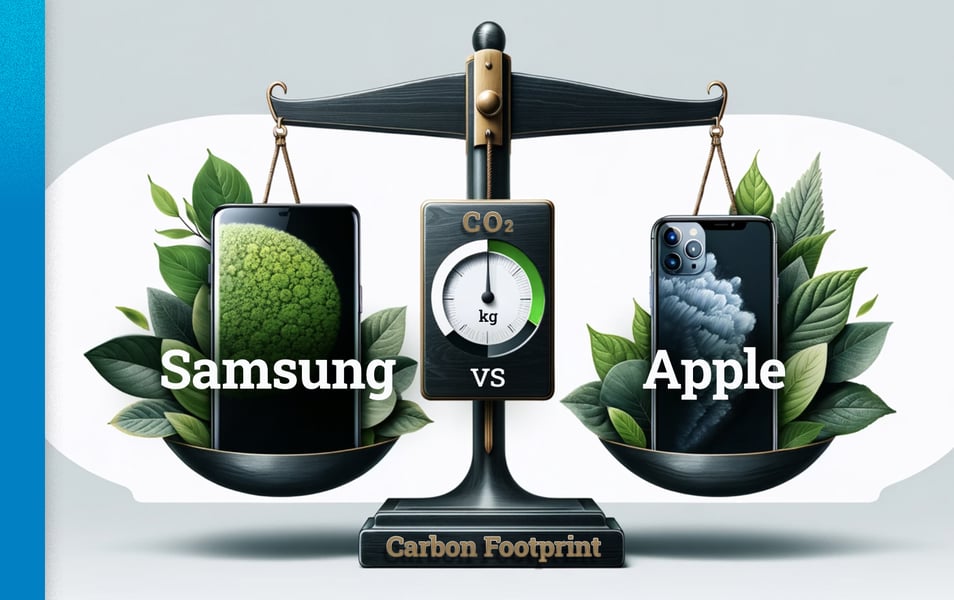Carbon footprint of production Samsung S24-series vs Apple iPhone 15-series

In our last post in this series, we talked about the average carbon footprint (CO₂e*) of Samsung and Apple smartphones (40 kg CO₂e). We also discovered that Apple, on average, emits 73% more CO₂e than Samsung. So, what else is there to say? What happens when we compare the flagships from these two brands? And which model has the highest emissions of all?
The chart below shows the CO₂e values from producing Samsung's and Apple's flagships. What's interesting here is that the gap between Samsung and Apple is smaller, but Apple still struggles more with sustainable production. Comparing the iPhone 15 Pro Max with the Galaxy S24 Ultra, the difference is 14% (61.5 vs. 53.8 kg CO₂e). This is significantly less than the 73% extra emissions Apple generally has over Samsung.

So, who's the top emitter?!
Is the Apple iPhone 15 Pro Max the phone with the highest CO2 emission? Nope, there are 6 other models with higher scores, including the iPhone X, iPhone 11/12 Pro, and 11/12 Pro Max.
The chart below lists the top 7. Interestingly, all these models are from Apple.

The result is quite unexpected: according to Apple's data, the iPhone 6, with an emission of 80.8 kg CO₂-equivalent, is the 'top emitter'. This is a result nobody probably saw coming. We couldn't find specific info on why its emissions are higher. Interestingly, the bigger version, the iPhone 6 Plus, emits significantly less, just 49.1 kg CO₂e.
In the next post (3 out of 5), we'll explore how the size of internal memory affects the carbon footprint.
*CO₂ vs CO₂e: CO₂e stands for "carbon dioxide equivalent". In plain language, CO₂e measures the total greenhouse gas emissions, expressed in the equivalent amount of carbon dioxide. On the other hand, CO₂ only measures carbon emissions and doesn't account for other greenhouse gases.
Source: Lifecycle reports from Samsung and Apple. The CO2 values of all iPhones concern the models with the lowest available internal memory (GB). The internal memory also affects CO2 emissions, but this aspect has been disregarded here. We've gathered and analyzed all the source info ourselves. Just a heads-up, you can't legally claim anything based on this.
Interested in the full CO₂ data sheets for all mobile devices from Samsung, Apple, and other brands? Shoot us an email at info@2service.nl for details and rates.
Related articles
-
 Shop owner info Circularity/sustainability
Shop owner info Circularity/sustainabilityWhat the EU Smartphone Product Passport Means for Your Repair Shop
Discover how the new EU Smartphone Product Passport can enhance repair efficiency, customer trust, and sustainability in your repair shop.
Read more -
 Parts Shop owner info Future insights Circularity/sustainability
Parts Shop owner info Future insights Circularity/sustainabilityHow the Right to Repair and Ecodesign regulations could affect the prices of spare parts.
Discover how new EU rules on Right to Repair and Ecodesign will impact spare parts pricing and repairability scores, making repairs easier and more affordable for technicians.
Read more -
 Future insights Market insights Circularity/sustainability
Future insights Market insights Circularity/sustainabilityWhy consumers opt for a new device, despite preference for repair
The recent Swappie survey (June 2024, among 1,000 Dutch consumers) reveals an important contradiction: although 80% of consumers are open to having their faulty smartphone repaired, 60% still end up...
Read more

